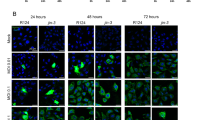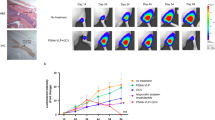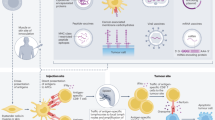Abstract
We previously identified a novel p53 target gene, RTVP-1, that possesses unique cytotoxic and immunostimulatory activities which make it potentially useful for cancer gene therapy. To test the therapeutic potential of RTVP-1 in a gene-modified tumor cell-based vaccine model, we used an adenoviral vector capable of efficient transduction and expression of RTVP-1 (AdRTVP-1), together with a highly metastatic mouse prostate cancer cell line (178-2 BMA). A vaccine was prepared with 178-2 BMA cells transduced with AdRTVP-1 or a control adenoviral vector expressing β-galactosidase (Adβgal). After irradiation of the cells, syngeneic 129/Sv mice were vaccinated three times at weekly intervals. After 3 weeks, they were challenged with orthotopic 178-2 BMA cells. After 21 days, fewer than 60% of the RTVP-1-cell-vaccinated mice developed tumors compared to 100% of the control mice. The RTVP-1-cell vaccine significantly reduced primary tumor wet weight compared with control Adβgal-cell vaccine (P<0.0001 at 7 and 14 days). Experimental metastasis to lung was also significantly reduced (P=0.0377), and survival significantly increased (P=0.0002). In addition, significantly increased NK and CTL activities were demonstrated in the AdRTVP-1-cell-vaccinated mice. These findings indicate that RTVP-1 gene-modified cell-based vaccines may be useful in the prevention of recurrent prostate cancer.
This is a preview of subscription content, access via your institution
Access options
Subscribe to this journal
Receive 12 print issues and online access
$259.00 per year
only $21.58 per issue
Buy this article
- Purchase on Springer Link
- Instant access to full article PDF
Prices may be subject to local taxes which are calculated during checkout



Similar content being viewed by others
References
Jemal A, Murray T, Ward E, Samuels A, Tiwari RC, Ghafoor A et al. Cancer statistics, 2005. CA Cancer J Clin 2005; 55: 10–30.
Moul JW . Prostate specific antigen only progression of prostate cancer. J Urol 2000; 163: 1632–1642.
Fong L, Small EJ . Immunotherapy for prostate cancer. Semin Oncol 2003; 30: 649–658.
Timme TL, Satoh T, Tahir SA, Wang H, Teh BS, Butler EB et al. Therapeutic targets for metastatic prostate cancer. Curr Drug Targets 2003; 4: 251–261.
Finn OJ . Cancer vaccines: between the idea and the reality. Nat Rev Immunol 2003; 3: 630–641.
Nabel GJ . Genetic, cellular and immune approaches to disease therapy: past and future. Nat Med 2004; 10: 135–141.
Antonia S, Mule JJ, Weber JS . Current developments of immunotherapy in the clinic. Curr Opin Immunol 2004; 16: 130–136.
Rosenberg SA, Yang JC, Restifo NP . Cancer immunotherapy: moving beyond current vaccines. Nat Med 2004; 10: 909–915.
Heiser A, Maurice MA, Yancey DR, Wu NZ, Dahm P, Pruitt SK et al. Induction of polyclonal prostate cancer-specific CTL using dendritic cells transfected with amplified tumor RNA. J Immunol 2001; 166: 2953–2960.
Sanda MG, Ayyagari SR, Jaffee EM, Epstein JI, Clift SL, Cohen LK et al. Demonstration of a rational strategy for human prostate cancer gene therapy. J Urol 1994; 151: 622–628.
Simons JW, Mikhak B, Chang JF, DeMarzo AM, Carducci MA, Lim M et al. Induction of immunity to prostate cancer antigens: results of a clinical trial of vaccination with irradiated autologous prostate tumor cells engineered to secrete granulocyte-macrophage colony-stimulating factor using ex vivo gene transfer. Cancer Res 1999; 59: 5160–5168.
Dranoff G . GM-CSF-based cancer vaccines. Immunol Rev 2002; 188: 147–154.
Ren C, Li L, Goltsov AA, Timme TL, Tahir SA, Wang J et al. mRTVP-1, a novel p53 target gene with proapoptotic activities. Mol Cell Biol 2002; 22: 3345–3357.
Murphy EV, Zhang Y, Zhu W, Biggs J . The human glioma pathogenesis-related protein is structurally related to plant pathogenesis-related proteins and its gene is expressed specifically in brain tumors. Gene 1995; 159: 131–135.
Rich T, Chen P, Furman F, Huynh N, Israel MA . RTVP-1, a novel human gene with sequence similarity to genes of diverse species, is expressed in tumor cell lines of glial but not neuronal origin. Gene 1996; 180: 125–130.
Gingras MC, Margolin JF . Differential expression of multiple unexpected genes during U937 cell and macrophage differentiation detected by suppressive subtractive hybridization. Exp Hematol 2000; 28: 65–76.
Ren C, Li L, Yang G, Timme TL, Goltsov A, Ren C et al. RTVP-1: a tumor suppressor protein inactivated by methylation in prostate cancer. Cancer Res 2004; 64: 969–976.
Satoh T, Timme TL, Saika T, Ebara S, Yang G, Wang J et al. Adenoviral vector-mediated mRTVP-1 gene therapy for prostate cancer. Hum Gene Ther 2003; 14: 91–101.
Shaker MR, Yang G, Timme TL, Park SH, Kadmon D, Ren C et al. Dietary 4-HPR suppresses the development of bone metastasis in vivo in a mouse model of prostate cancer progression. Clin Exp Metastasis 2000; 18: 429–438.
Tahir SA, Yang G, Ebara S, Timme TL, Satoh T, Li L et al. Secreted Caveolin-1 stimulates cell survival/clonal growth and contributes to metastasis in androgen-insensitive prostate cancer. Cancer Res 2001; 61: 3882–3885.
Satoh T, Saika T, Ebara S, Kusaka N, Timme TL, Yang G et al. Macrophages transduced with an adenoviral vector expressing interleukin 12 suppress tumor growth and metastasis in a preclinical metastatic prostate cancer model. Cancer Res 2003; 63: 7853–7860.
Saika T, Satoh T, Kusaka N, Ebara S, Mouraviev VB, Timme TL et al. Route of administration influences the antitumor effects of bone marrow-derived dendritic cells engineered to produce interleukin-12 in a metastatic mouse prostate cancer model. Cancer Gene Ther 2004; 11: 317–324.
Lee HM, Timme TL, Thompson TC . Resistance to lysis by cytotoxic T cells: a dominant effect in metastatic mouse prostate cancer cells. Cancer Res 2000; 60: 1927–1933.
Ribas A, Butterfield LH, Glaspy JA, Economou JS . Current developments in cancer vaccines and cellular immunotherapy. J Clin Oncol 2003; 21: 2415–2432.
Acknowledgements
This work was supported by grants from the NCI (ROI-50588) and Specialized Program for Research Excellence (SPORE, P50-58204). Portions of this work were conducted in facilities provided by the Houston VA Medical Center.
Author information
Authors and Affiliations
Corresponding author
Rights and permissions
About this article
Cite this article
Naruishi, K., Timme, T., Kusaka, N. et al. Adenoviral vector-mediated RTVP-1 gene-modified tumor cell-based vaccine suppresses the development of experimental prostate cancer. Cancer Gene Ther 13, 658–663 (2006). https://doi.org/10.1038/sj.cgt.7700919
Received:
Revised:
Accepted:
Published:
Issue Date:
DOI: https://doi.org/10.1038/sj.cgt.7700919
Keywords
This article is cited by
-
Glioma pathogenesis-related protein 1 performs dual functions in tumor cells
Cancer Gene Therapy (2022)
-
GLI pathogenesis-related 1 functions as a tumor-suppressor in lung cancer
Molecular Cancer (2016)
-
Tumor growth and metastasis suppression by Glipr1 gene-modified macrophages in a metastatic prostate cancer model
Gene Therapy (2011)
-
Identification of GLIPR1 tumor suppressor as methylation-silenced gene in acute myeloid leukemia by microarray analysis
Journal of Cancer Research and Clinical Oncology (2011)
-
Inhibition of HIV-1 replication by small interfering RNAs directed against Glioma Pathogenesis Related Protein (GliPR) expression
Retrovirology (2010)



